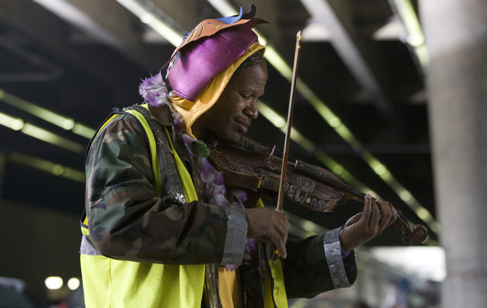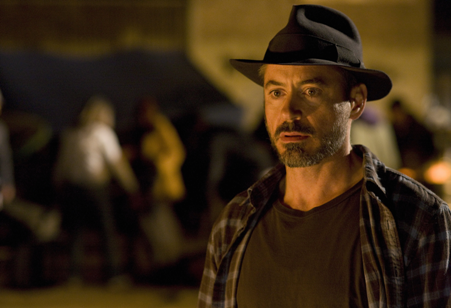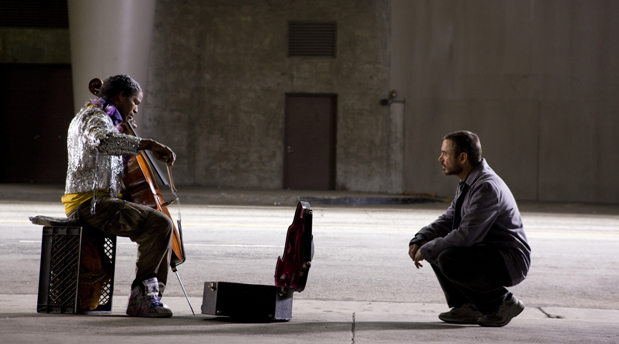


Jamie Foxx as Nathaniel Ayers, the musical prodigy, and Robert Downey Jr. as
Los Angeles Times columnist Steve Lopez, in Joe Wright's film "The Soloist",
which opened in the U.S. and Canada today.
(Photos: Francois Duhamel/Dreamworks-Paramount Pictures)
MOVIE REVIEW
The Soloist
Clefs,
Cracks And Crevices In Los Angeles, And All The Other Music In Between
By
Omar P.L. Moore/PopcornReel.com
SHARE
Friday, April 24, 2009
Los Angeles, as Tom Cruise's Vincent character once remarked in the film
"Collateral" (2004), is "too sprawled out, disconnected . . . six hours [a
man's] riding the subway his corpse doing laps around L.A. . . .
nobody notices."
Filmmaker Joe Wright notices though, and pays special attention in "The
Soloist", a rousing and affecting film, one of the best American movies of
the year. Mr. Wright's film examines the cracks and crevices of Los Angeles
in 2005 -- the year following the release of "Collateral" -- and what lies
within the cracks aren't merely glimpsed. Spotlights -- namely Seamus McGarvey's scintillating cinematography -- shine on the very people and
things that millions of cars on the tangled mass of L.A. freeways breezily
speed past.
Purely as a study of the subterranean elements in the City Of Angels, "The
Soloist" would be astounding -- and equally brilliant as a essay
on anthropology. And yet "The Soloist" isn't really about either of
those things, for finding harmony in your individual voice and sound are the
heart and soul of Mr. Wright's film, based on the true story of Nathaniel
Anthony Ayers, a talented Juilliard School cello player and music prodigy homeless on L.A.'s
Skid Row, blighted with bouts of severe paranoid schizophrenia. Jamie Foxx
plays Mr. Ayers with open-hearted endeavor, inhabiting his character with
complete confidence and authenticity, while Robert Downey Jr. layers Los
Angeles Times columnist Steve Lopez with nuance and a worn sarcasm.
Mr. Ayers and Mr. Lopez strike up a casual friendship and soon the latter is
writing stories about
the former in Mr. Lopez's "Points West" Times
columns.
Susannah Grant wrote "The Soloist" screenplay, based on Mr. Lopez's book The
Soloist: A Lost Dream, an Unlikely Friendship, and the Redemptive Power of
Music and implements the nuances of four distinct L.A. worlds to great
effect as towering characters. There's Disney Hall, where Mr. Ayers
tries regaining his musical prowess; the Los Angeles Times building and its
newsroom culture, an institution representing both an engaged and apathetic
public in equal measure; Skid Row, an "underground" where vivid and vibrant
souls have long been forgotten, and finally, the infinite, monotonous
spaghetti junction of motorists who crawl or scamper -- depending on the
traffic -- like agitated ants or angry cockroaches, encased in steel.
As in Paul Haggis's Oscar-winning film "Crash" (2005) each of these slices
of Los Angeles collides with the other in "The Soloist", with Mr. Lopez's
reluctant but definitive immersion into the depths and heights of Skid Row
tangentially bumping on all four environs. The main theme or raw soundtrack
of "The Soloist" is a cacophony of competing voices straining to be heard,
whether in the Times newsroom where the cross-talk and
Howard Hawks' banter of "His Girl Friday"
(1947) is in full effect early on; or via the breathless monologue of Mr.
Ayers in his first encounter with Mr. Lopez who struggles to get a word in
edgewise; or in the endless arrhythmic cadences of the members of Lamp
Community, a real-life homeless housing facility in Skid Row; or through the
shouting of motorists and honking of horns.

But wait -- there's additional music within this multifaceted discordance --
and cellist Ben Hong plays it. Mr. Hong's extraordinary rendition of the
varied instrumentations backing Mr. Foxx, an accomplished musician himself,
make Mr. Wright's film a bigger, ever more moving success. Mr. Wright does
a phenomenal job amalgamating concerns circa 2005: displacement via
Hurricane Katrina, lawlessness of political governmental authority (macro
and micro), mental illness and terrorism (the July 7 London bombings) and
stitches them seamlessly into a film that runs comfortably under two hours.
Sometimes film critics can't resist doing the following, either for
analogy's sake or in the otherwise fruitless search for some kind of
parallel meaning: Mr. Foxx's Nathaniel Ayers could have been a continuation
of the actor's Oscar-nominated turn as Max Durocher, whose dream in
"Collateral" may have been long since extinguished, fully exploding in his
face. In that film, Mr. Foxx's L.A. taxi-driving Max, who urges one
passenger to "get harmonic", had a plan to own a business called Island
Limos, a fleet of limousines. Mr. Cruise's Vincent predicts that Max will
wind up in a Barcolounger, static from inaction on his dream business. In
"The Soloist", Mr. Foxx's latest L.A. incarnation is not only without a limo
-- he can barely manage to haul a shopping cart along the city's sidewalks.
Though both movies have little in common except for studio,
location and lead star, their juxtaposition and L.A. setting illustrate --
at least according to one character in the film "Training Day" -- the
emotions of "smiles and cries", with the difference between the two
very small indeed. Amazingly, the legendary Miles Davis (mentioned in "Collateral"),
flunked out of Juilliard in his sophomore year, just like the real-life Mr.
Ayers did. (As a further aside: coyotes, a momentary character in
"Collateral", make their presence felt even more in "The Soloist", along
with raccoons, in humorous circumstances.)
The performances of the two central figures of "The Soloist" hold the movie
in place. There's a moment of either incredible coincidence or skillful
improvisation by Mr. Foxx when he appears in whiteface in one scene
while talking to Mr. Downey's character. (That Mr. Downey appeared in
blackface in
"Tropic Thunder" and received an
Oscar-nomination earlier this year for his performance in the film accounts
for the grandest irony in Mr. Wright's well-crafted film.) Mr. Downey has
played journalists both fictional and factual, with satirical flair
("Natural Born Killers"), comedic cynicism ("Zodiac")
and here in Mr. Wright's film with empathetic and introspective
brilliance. Now one of the top five American actors of his era, Mr. Downey
showcases a range and believability that you take for granted -- yet you
still marvel at his work here, supplemented with one or two Pacino-isms that
fanatics of films like
"Heat" (another L.A. story), will recognize. For the
record Mr. Downey too is a musician, releasing an album in 2004 on which he
sang ballads and classic tunes.
"The Soloist" has a few momentary lapses: inevitable scenes of melodrama and
conflict which it doesn't need, since the actors create these tensions all
by themselves without the further dramatizations -- and although a cauldron
of different voices (most likely those of a coldhearted society) invade Mr. Ayers'
head during the film, they could have been dispensed with. As with
"Atonement", Mr. Wright with his debut Hollywood film has
a cinematic centerpiece scene which captivates the audience -- the three
minutes of this scene are beautiful -- and grabs its heart. (You'll easily
recognize where the scene is in the film.) Throughout, Mr. Wright
forages deep for every moment
of joy, heartache, pain, pleasure and the symphonies of humanity that greet
us, and he scores one memorable winner of a movie in the process.
With: Catherine Keener, Tom Hollander, Nelsan Ellis and Lisa Gay Hamilton.
"The Soloist" is rated PG-13 by the Motion Picture Association Of
America for thematic elements, some drug use and language. The film's
running time is one hour and 49 minutes.
SHARE
Related: Interview with "Soloist" director Joe Wright
Related:
PopcornReel.com YouTube Review of "The Soloist"
Copyright The Popcorn Reel. PopcornReel.com. 2009. All Rights Reserved.
